My current sql:
select s.dcid, substr(s.lastfirst,0,3), to_char(a.att_date, 'mm/dd/yyyy'), a.periodid, p.name, a.attendance_codeid, ac.att_code, count(*)
from students s
join attendance a on s.id = a.studentid
join period p on a.periodid = p.id
join attendance_code ac on a.attendance_codeid = ac.id
WHERE ac.att_code IS NOT NULL
AND s.schoolid = 109
AND s.enroll_status = 0
AND s.student_number = 100887
AND a.att_date >= to_date('08/15/2013', 'mm/dd/yyyy')
group by s.dcid, s.lastfirst, to_char(a.att_date, 'mm/dd/yyyy'), a.periodid, p.name, a.attendance_codeid, ac.att_code
Output:

I would like to get the output to sequentially number each record where the count(*) column is, starting with 1 at each new group, and put a total at the bottom of the group, but I'm not sure how to do that. I have tried rollup at various parts of the group by expression, but it winds up giving subtotals for the dates, periodids, etc... I need it to total ONLY for the student (either s.dcid or s.lastfirst)
[Additional information per request...]
I'm hoping to achieve a report where my end users can search for students who have a given number of attendance records in a date range. For example, if the end user wants to find students who have 20 absences between 10/1/2013 and 10/31/2013, where the att_code is one of A,C,E,G... etc. Once the report runs, I want to show them the date the absence occurred, and the code that was used as a visual verification that the records found do indeed match their search criteria.
The output should look like the current output with the exception of the COUNT(*) column, which is where I'm hung up right now. I like how row_number sequentially numbers each record, but what I'm still seeking is how to reset the sequential numbering when the group (the student) changes.
For example...
DCID S.LASTFIRST A.ATT_DATE PERIODID NAME ATT_CODE COUNT(or # or Num...)
1006 Aco 08/29/2013 1704 4 W 1
1006 Aco 09/03/2013 1701 1 6 2
1006 Aco 09/05/2013 1706 6 G 3
...
1006 Aco 10/04/2013 1706 6 z 20
2543 Bro 08/29/2013 1704 4 W 1
2543 Bro 09/03/2013 1701 1 6 2
2543 Bro 09/05/2013 1706 6 G 3
...
2543 Bro 10/04/2013 1706 6 z 20
3121 Com 08/29/2013 1704 4 W 1
3121 Com 09/03/2013 1701 1 6 2
3121 Com 09/05/2013 1706 6 G 3
...
3121 Com 10/04/2013 1706 6 z 20
Of course, in this example, I am abbreviating the output by replacing row numbers 4 - 19 in each of the three groups with '...' I don't want to literally output this.